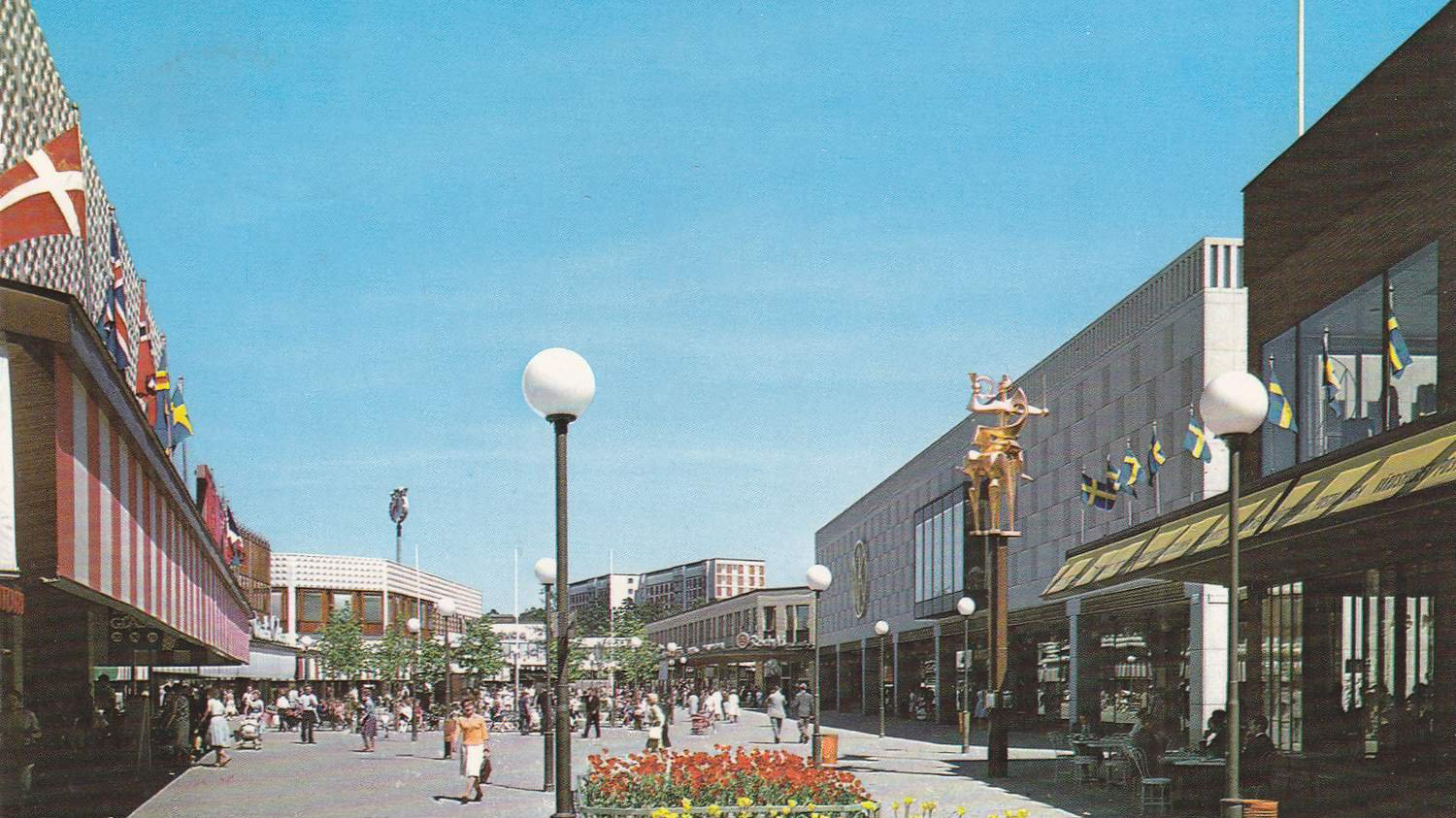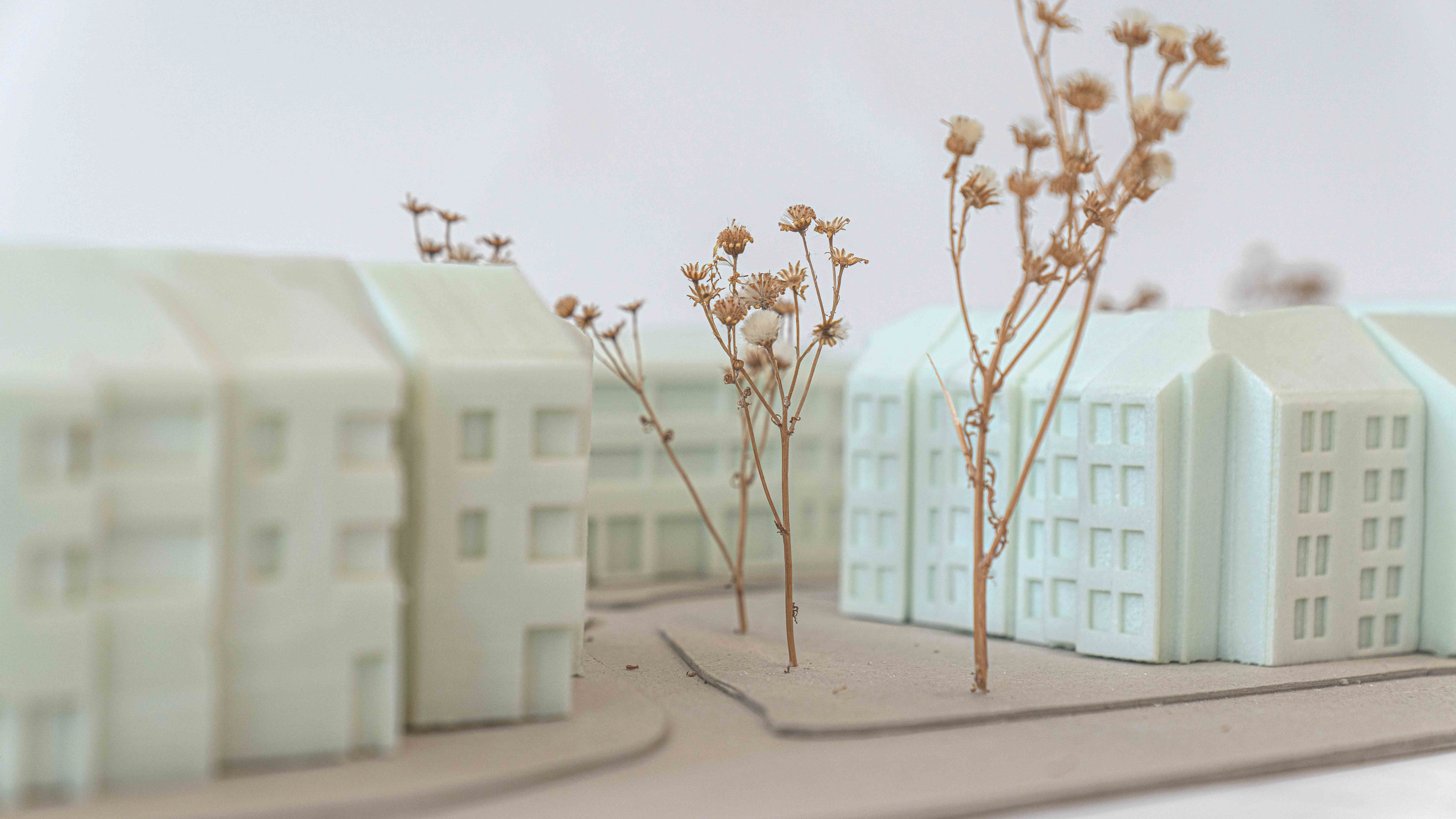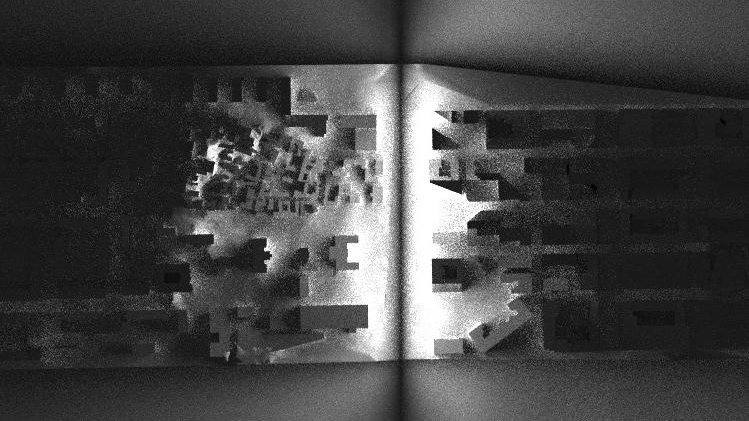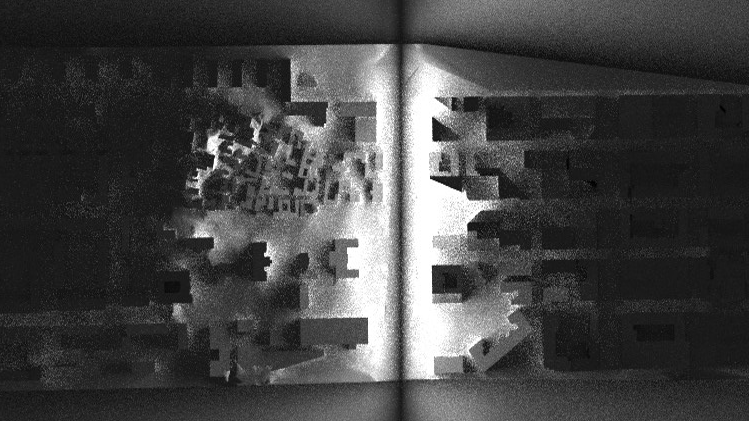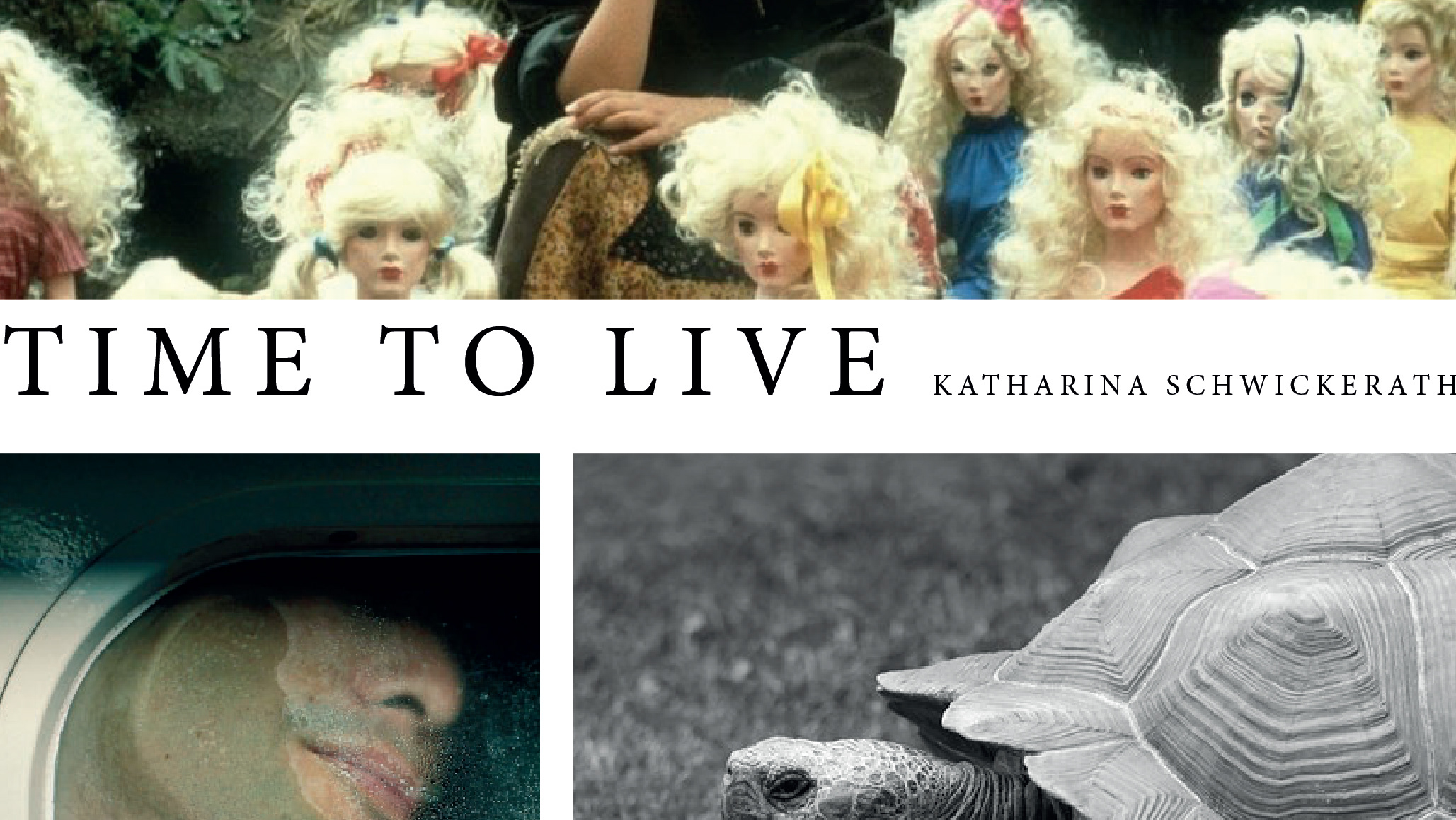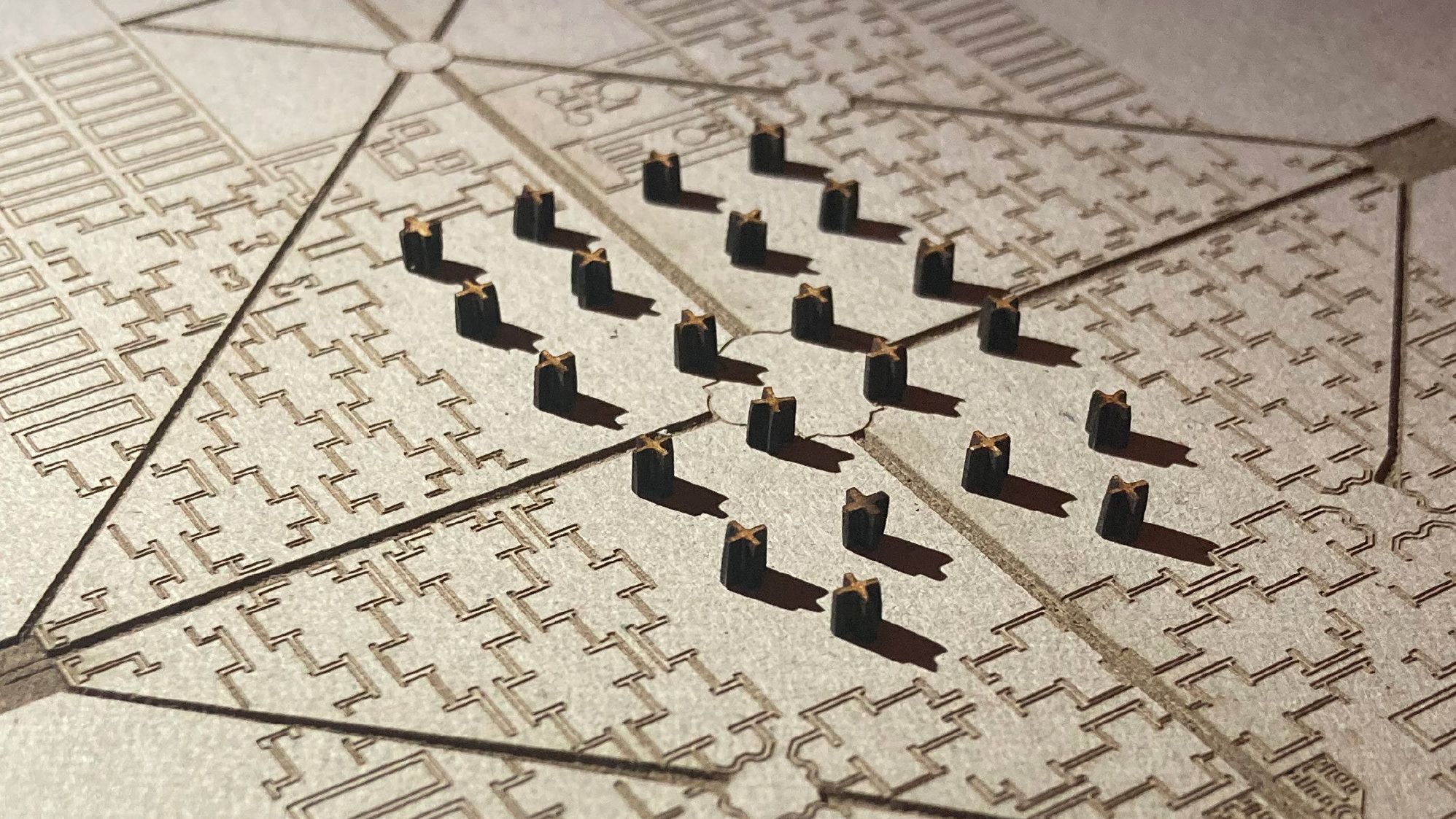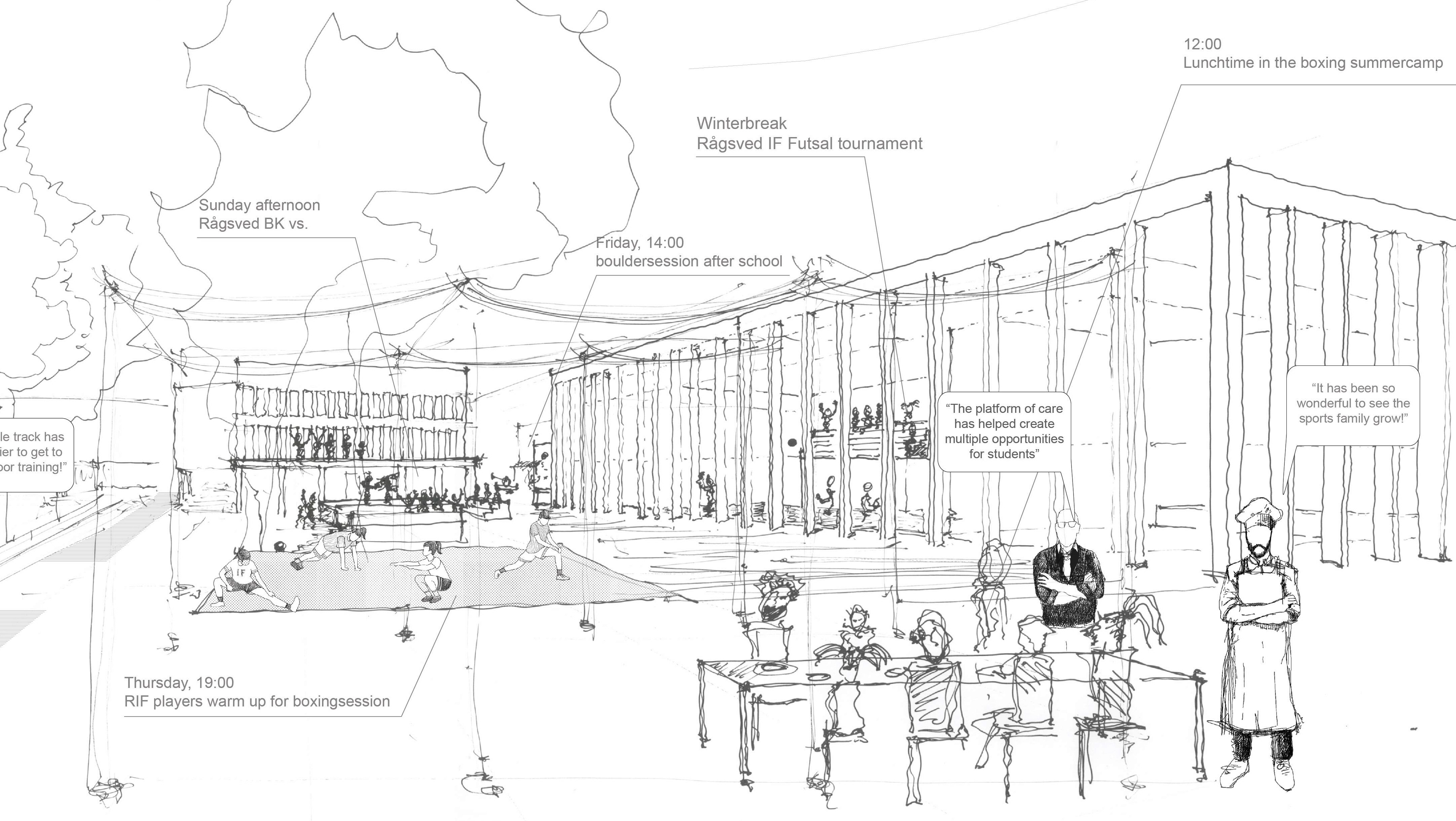STOCKHOLM'S PANTRY
Master Dissertation
Urban Planning and Design
KTH Royal Institute of Technology
2024
individual work
supervised by Alejandra Navarrete Llopis
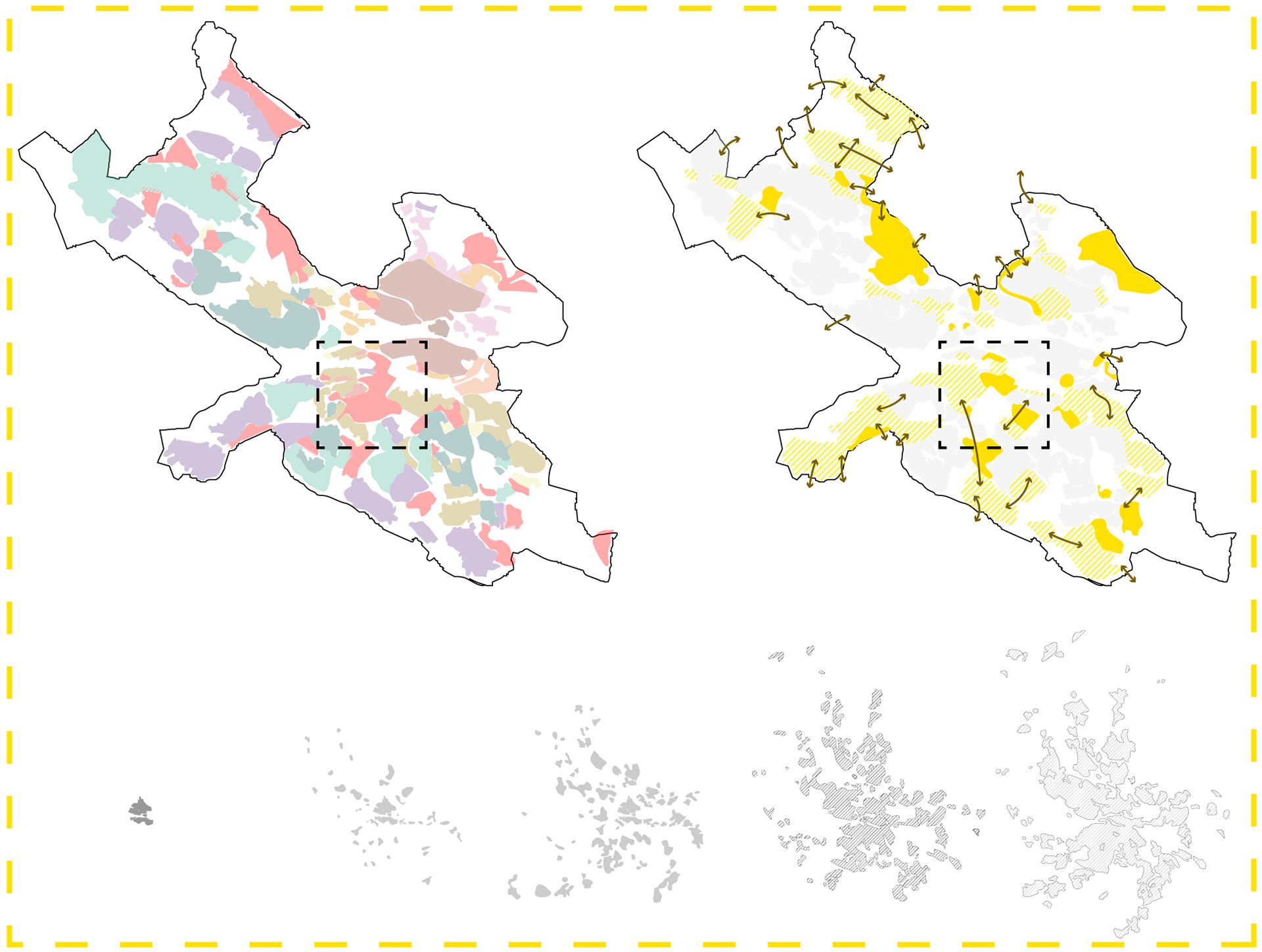
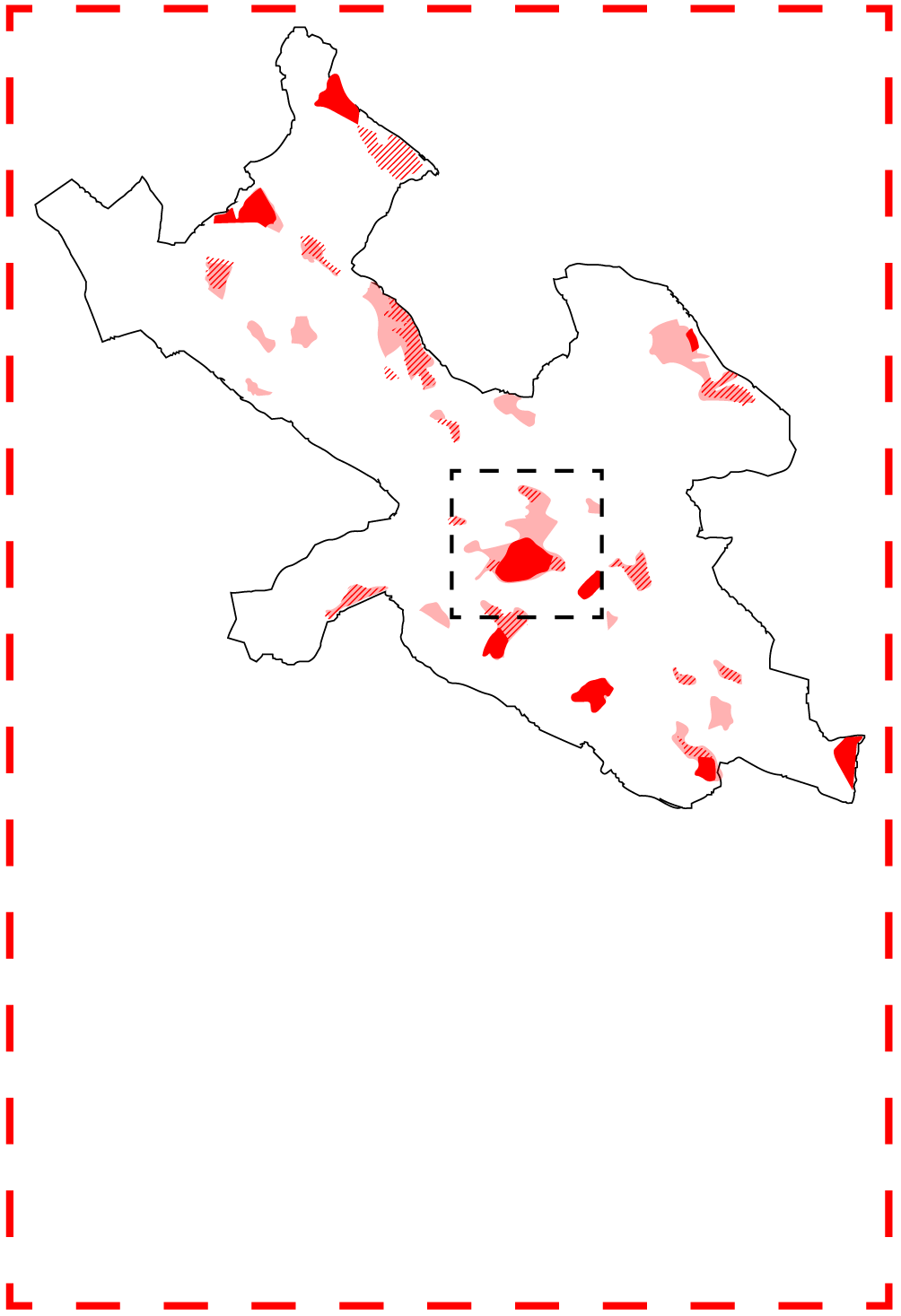


The Årsta Food Wholesale Market serves as the focus of my master’s thesis. The food supply system constitutes a critical component of urban infrastructure and is essential for the well-being of the city’s inhabitants. A range of interconnected processes must function efficiently to ensure that consumers can reliably access basic food provisions, such as breakfast, on a daily basis. Within this supply chain, the wholesale market acts as a crucial intermediary, linking food producers to retailers.
The first wholesale market in Stockholm was established in 1912 adjacent to the central station, but was relocated to Årsta in 1962 due to limited space in the city center.
In my analysis, I identified three key factors that shape the context of this site: urban development, industrial zones, and food distribution networks. These factors collectively influence the operational dynamics of the market and its role within the broader food supply chain.
An analysis of Stockholm's urban growth since the 1200s reveals that the city expanded spatially until the end of the 20th century. However, as described in Stockholm: The Making of a Metropolis, the process of densification has been a defining characteristic of the early 21st century. One of the key objectives in Stockholm’s urban planning is to integrate existing neighborhoods with new developments, thereby fostering a more cohesive and inclusive city.
Turning to the second lens of analysis—industrial areas—there has been a significant decline in both the number and size of industrial zones within the city's boundaries. In recent years, these industrial areas have increasingly become mixed-use spaces, contributing to the broader densification process.
The third lens of my analysis focuses on food distribution. As previously mentioned, the Årsta Food Wholesale Market has historically played a pivotal role in the city's food distribution network. However, there is an ongoing shift in this domain, as large, modern logistics centers have been constructed in the northern part of Stockholm to serve retail distributors. While the Årsta wholesale market continues to primarily supply food to local processors such as restaurants and bakeries, these new logistics hubs are reshaping the landscape of food distribution in the region.
This thesis focuses on a specific segment of the food value chain. Since 2020, all EU member states have been required to measure and report food waste in a standardized manner. Additionally, there is a proposal for an EU-wide binding target aimed at reducing food waste. The overarching global objective outlined in Agenda 2030 is to halve food waste by the year 2030. In alignment with this goal, the Swedish government has established national targets for 2025, which include a reduction of food waste by one-fifth and a decrease in food loss.
From the study Sustainability Assessment of Food Redistribution Initiatives in Sweden by the Swedish University of Agricultural Sciences, I gained insights into existing strategies for redistributing surplus food. The researchers highlight that the connection between food waste prevention and redistribution to those in need is a relatively recent phenomenon. This development sparked my interest, as I aim to explore how a more sustainable approach to food consumption can be cultivated.
Characteristically for Söder om Söder is the areas industrial history with lots of strategically important infrastructure (red). being the industrial suburb of Södermalm, however the area developed more and more towards a threshold space between the stone city and the outskirts. The existent industrial areas Årsta partihallar and Västberga should be protected as purely industrial.
Looking through the urban development Lense. Heterogenous area with urban housing developments from different times like the garden city movement, narrow housing era, the early steps of the Million Programme, Midsommarkransen the worker settlement.
It consists of many diverse fragments of historical urban planning agendas, that are located next to another but not really communicating with each other.
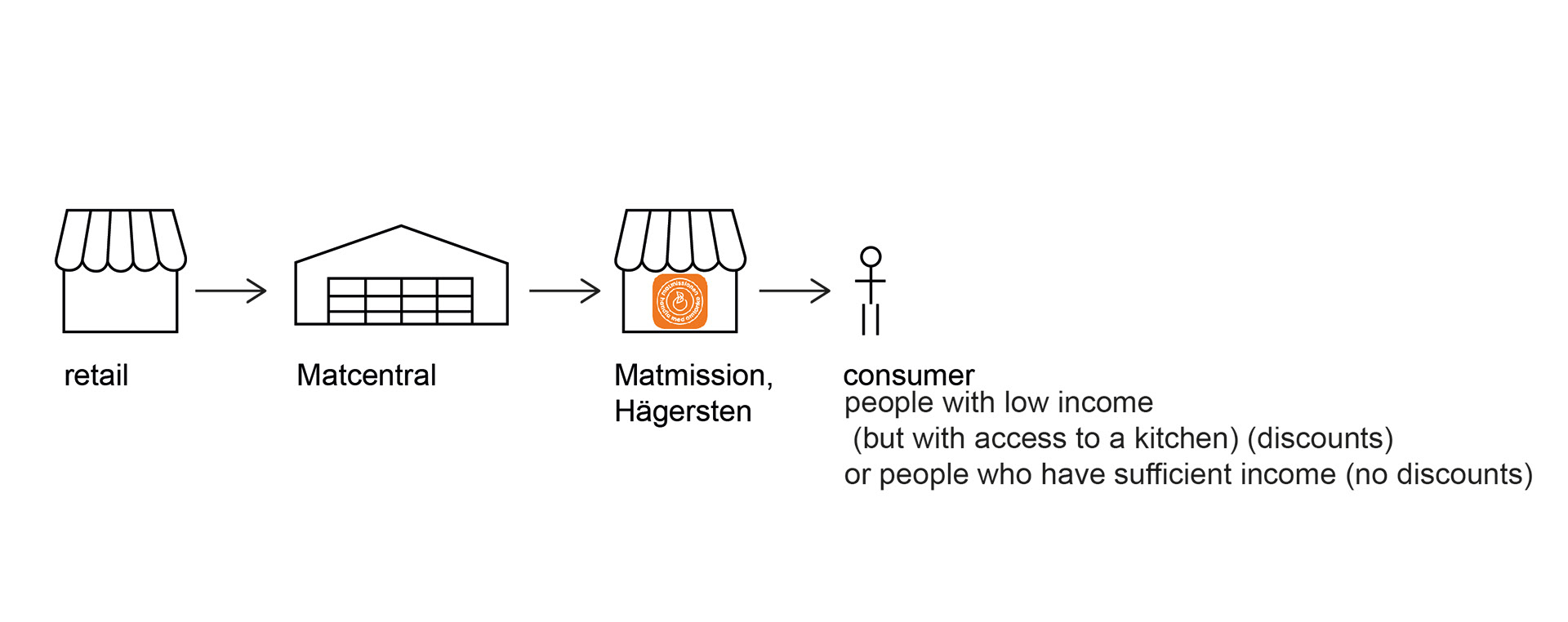
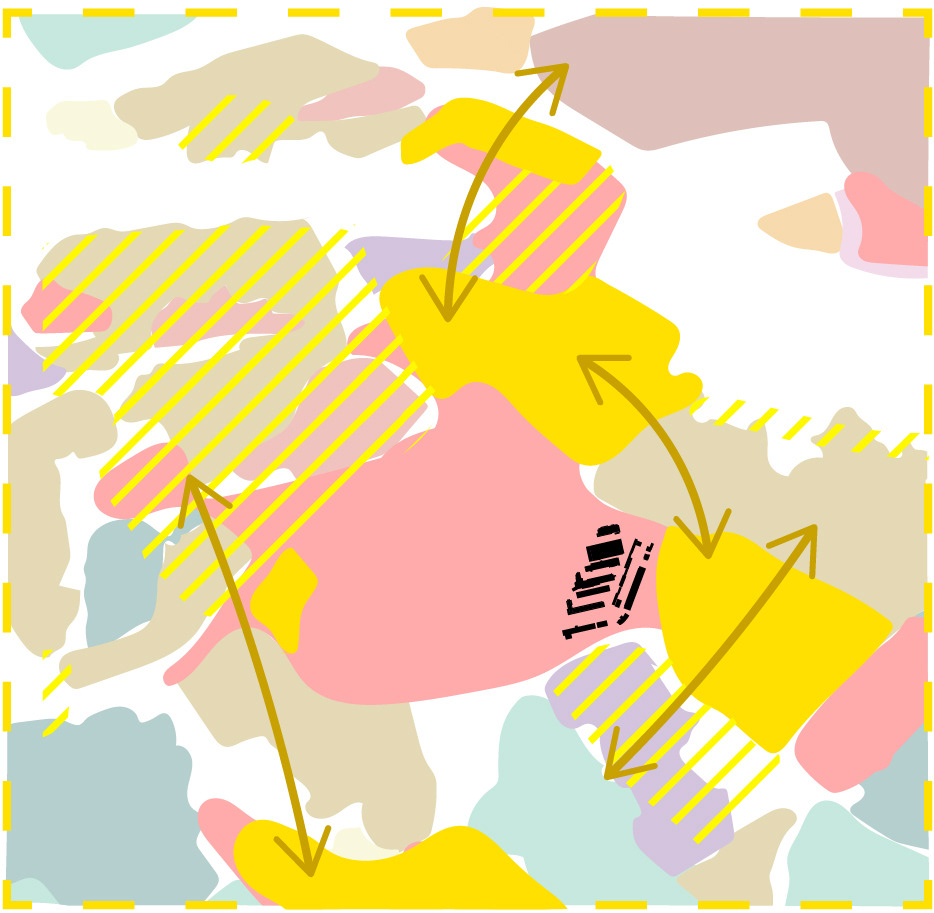
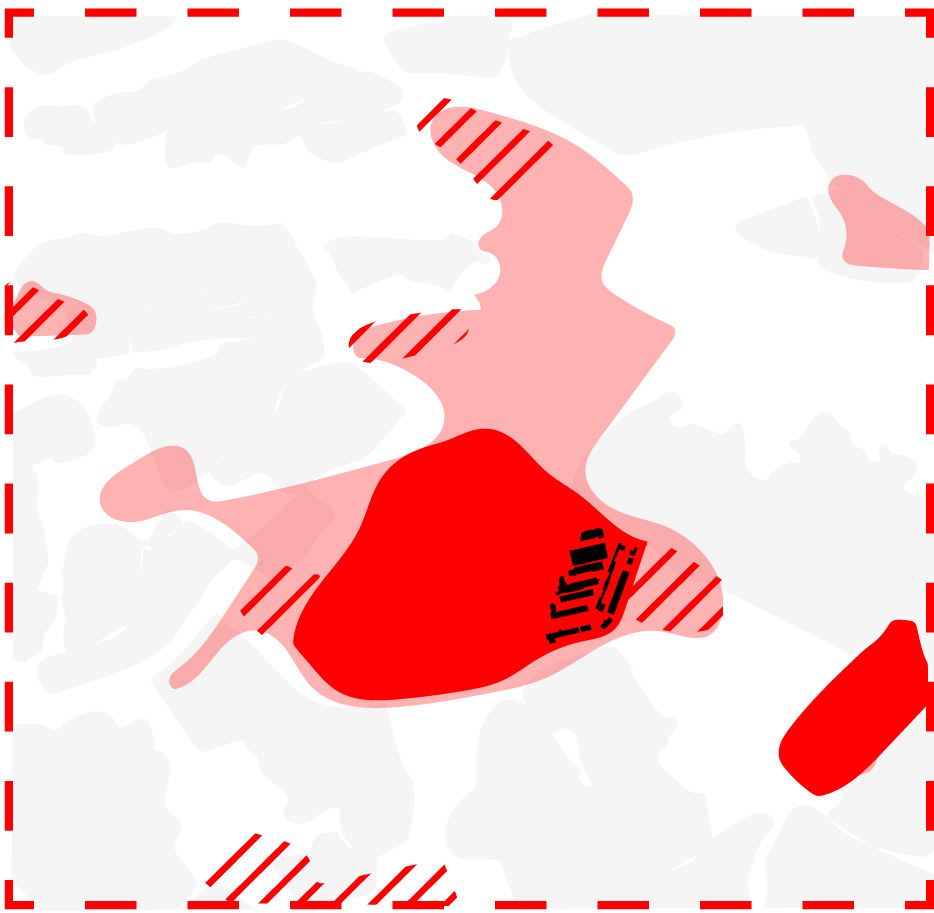
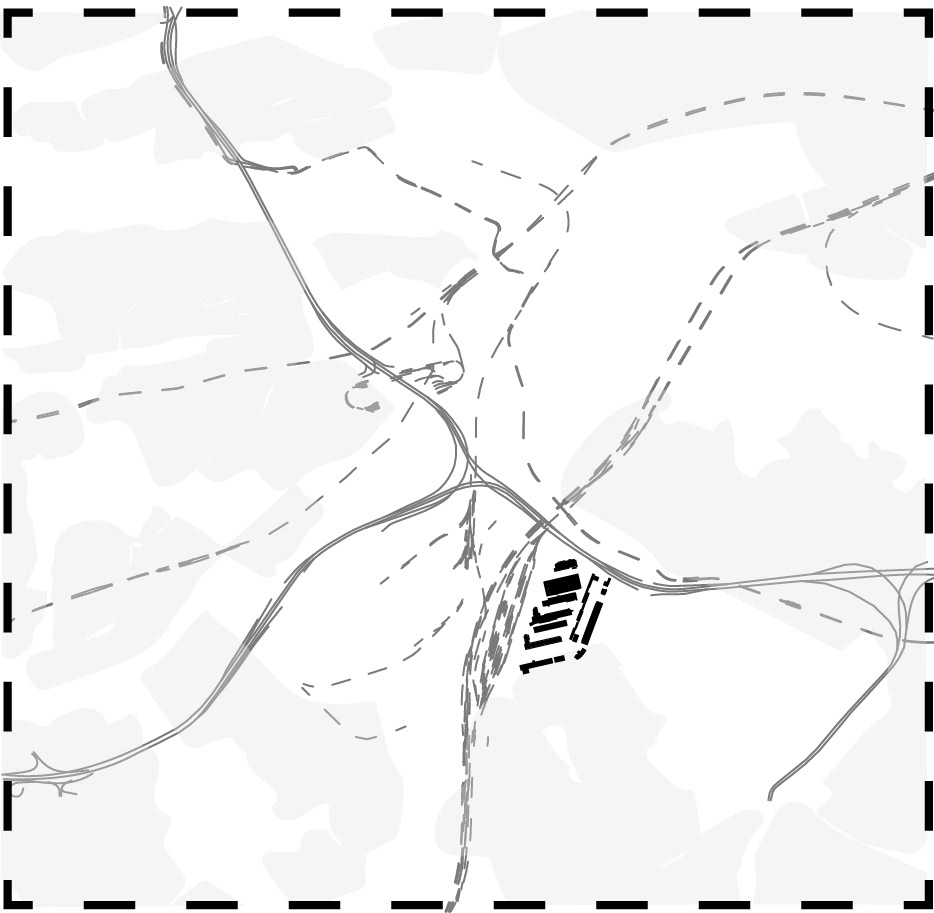
Söder om Söder today is one of the areas in Stockholm with the biggest urban development’s potential - in line with the municipality’s basic course of growth through densification and connecting neighbourhoods - there are lots of plans and ongoing developments, including a metro line and one of the biggest developments immediately next to my site - Årsta Fältet. Talking about connections of the area, I want to highlight the main commuter bike lanes and pedestrian paths that are planned to weave the two areas - Östberga and Årsta Fältet.
Moving on to my 3rd Lense food distribution, my site comes into focus. arsta wholesale market nowadays is the place where the restaurants, canteens, bakeries – local food business buy their products. I mapped the local food processors which are potential clients of the wholesale. Besides the distribution of food there is also a place of redistribution of surplus food in Söder om Söder. Matmissionen the first social supermarket opened its doors in Hägersten in 2015.
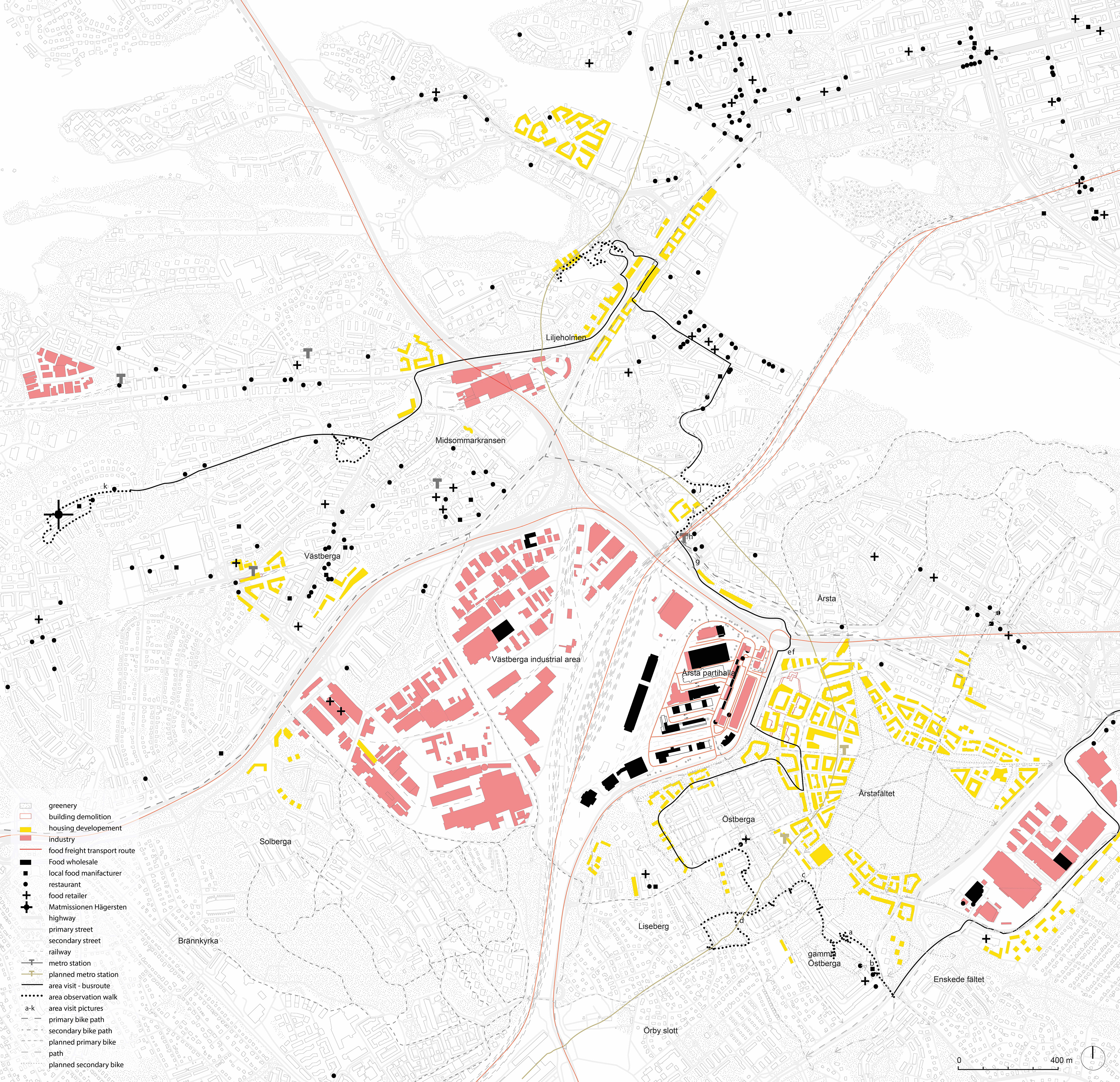

Let’s have a look at my site first.
there’s lots of movements happening at the moment - Årsta wholesale is in transition. Some of the halls are currently empty - or are going to be free since for example Dagab (distributor of Axfood) built a new hall in the north. The amount oriental food wholesalers and increases. Also, a bakery, for high end baking products moved here and opened a small coffee. Tune inn, a music production company moved here.
During my site visit I started understanding that the food wholesaling is not only about the making business and big companies but also a workplace for many people. I interviewed several different workers about the site as a workplace. some of them collecting food every day, others like the long-distance truck driver Leni from Germany spending several days sleeping in parked truck in between the railway tracks and the road. When I asked about their wishes for improvement some workers want space for lunch breaks, to relax and, for long-distance drivers, to shower and socialize.
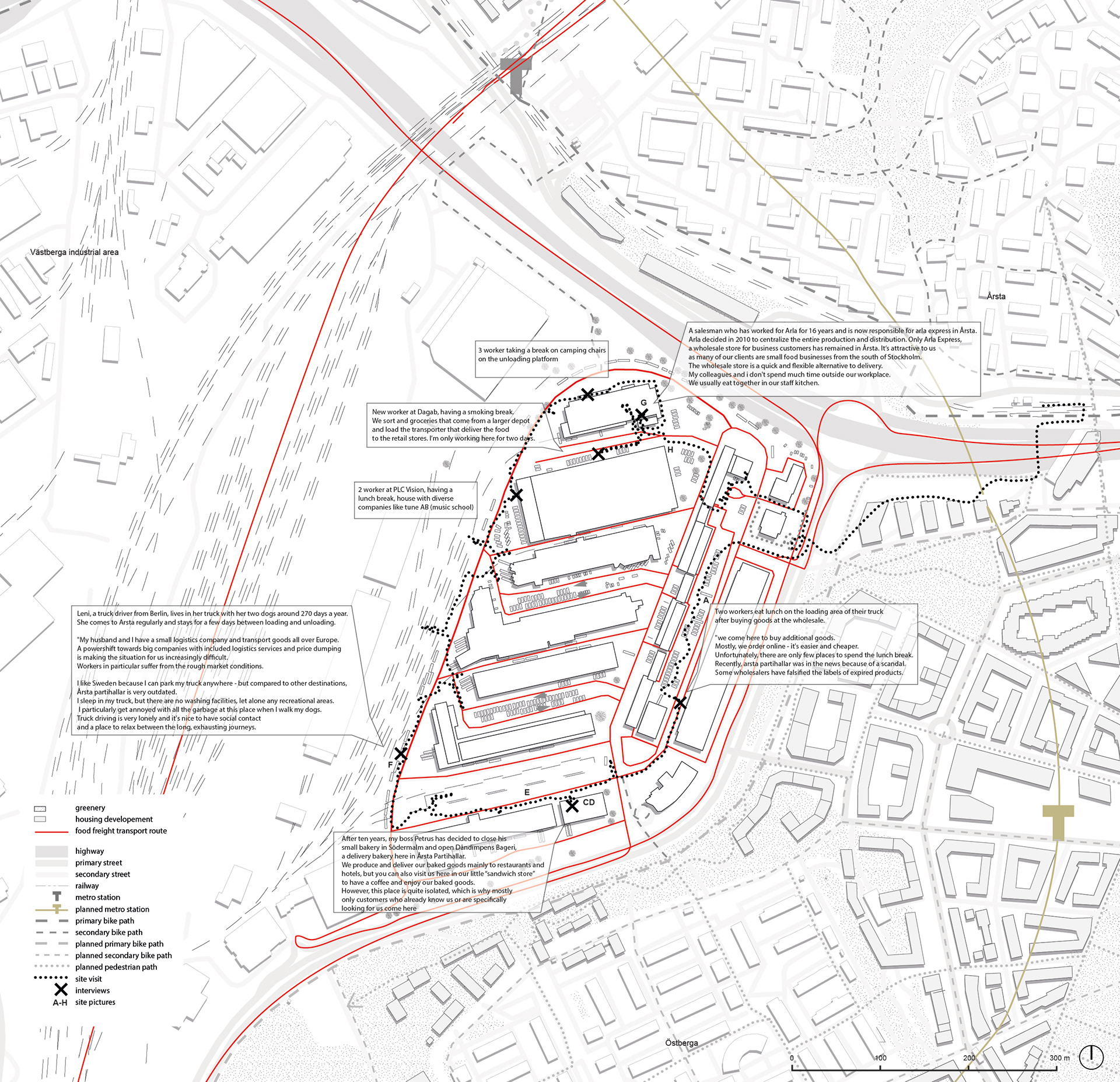

Conclusion:
The densification process and the aim to connect the neighbourhoods to create a coherent inclusive area.
We have dedicated pure industrial areas that coexist with the densifying residential areas. And there’s a need for rethinking the role of site as a workplace and as an infrastructural place of efficiency. But also, there’s a challenge to rethink our food consumption for a more environmentally friendly and social just future.
In my project, all the different lenses melt together.
Food is the catalyst to connect and bond people, to bridge social and spatial gaps in Söder om Söder.
Årsta partihallar will become a cultural magnet for the surrounding neighbourhoods. The goal is a socially and environmentally sustainable approach through and to food.
In my proposal, Årsta partihallar is the core of a network of redistribution of surplus food.
The network will be a cooperation of the retailer, the local food processors, the redistribution units and the individuals. Surplus goes from the retailers and the local businesses to a storage, and from the storage, local businesses and retailer can collect surplus food to offer it in their locations. The redistribution units will be located on site.
The site will be transformed in 4 phases:
Phase one: developing the core, organizing streets
Phase two: connecting the neighbourhoods and expanding the core
Phase three: a highline for the north south connection of the neighbourhoods
Phase 4: the site will grow together, depending on future changes, expanding research, storage, and market
To provide efficient infrastructure I propose the reorganization of the one ways streets in loops with separation of delivery and collection. All the existing businesses will remain in their place and can continue their business.
On closed railway tracks there will be small wagons with worker facilities to sleep shower and play cards.
the surplus food storage will be in this building, that is currently empty. The biggest building of wholesale market is soon to be empty when Dagab moves out. This will be the core of Stockholm’s pantry. Oriented on the redistribution units analysed in the research paper, the core will include a food bag centre, a surplus food supermarket (like Matmissionen) which will also provide space for new alternative contributions for sustainable food reprocessing. In addition to that, a research centre for environmentally and social sustainable food supply will be located here to enable an exchange of knowledge of theory and practice.
A communal kitchen as the social gathering place for eating meeting relaxing and partying.
To embed the site with the surroundings and to make it a connecting element of the area, pedestrian paths and bike lanes from the station all directions will lead through the site.
The music production “tune in” will be cooperating with a Kulturhuset and the core - hosting culture festivals here.
The fruit garden with fruit trees and vegetable patches together with the greenhouses on the rooftops are used for food education, research and as a kitchen garden for the communal kitchen.

